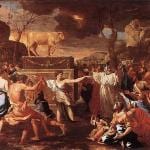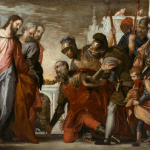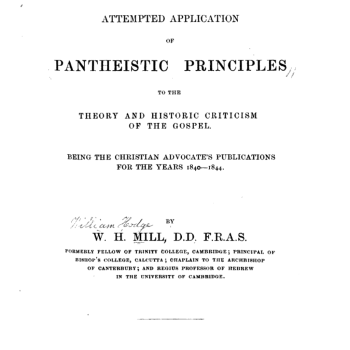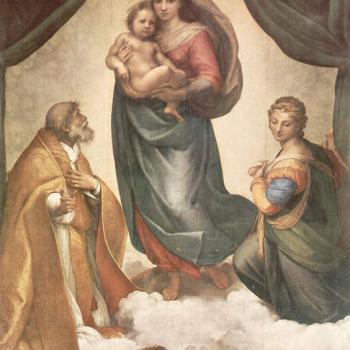
Some liberal Catholics claim that the Gospel of Mark presents a very unflattering picture of Mary and Jesus’ extended family. If they don’t understand ancient near eastern culture and idiom and ways of thinking and speaking and writing, yes, there would likely be some misunderstandings. Liberal Catholics too often fall right into them, along with anti-Catholic Protestants, who also have an anti-Catholic and anti-Marian agenda to push.
It’s remarked by these liberals that nary a word about Mary appears in the New Testament. Exactly! The relevant question, however, is why? Mary was humble and all about her Son Jesus, and the New Testament is overwhelmingly concerned about Him as well, as would fully be expected concerning the God-Man and Savior and Redeemer. There was plenty of time through the centuries for Christians to ponder Mary and her role and to highly develop Marian theology. First things first.
Now I shall deal with the argument which maintains that the Blessed Virgin Mary actually thought Jesus was nuts / mentally ill / out of his mind / mad (or other equivalent term). Isn’t that a “pious” thought for a proclaimed Catholic to have? [heavy sarcasm]
Mark 3:21-22 (RSV) And when his family heard it, they went out to seize him, for people were saying, “He is beside himself.” [22] And the scribes who came down from Jerusalem said, “He is possessed by Be-el’zebul, and by the prince of demons he casts out the demons.” (cf. Jn 10:20-21)
Note the italicized and bolded word. Other translations (including, unfortunately, KJV, NKJV, NIV, NASB) make it sound like Jesus’ family were agreeing and/or saying that Jesus’ was mad, but in fact the text is saying that “people” in general were doing so (just as the Pharisees did).
But if the text doesn’t refer to them, it can simply be construed as His family coming out to remove Him from the crowds, who were massively misunderstanding Him, accusing, and perhaps becoming violent (as at Nazareth, when they tried to throw Him over a cliff). Hence, there would be no necessary implication of His family’s (let alone Mary’s) disbelief in Him. They were concerned for His safety. Other translations convey the true sense of the passage (which is interpreted by 3:22 indicating that the “scribes” were saying Jesus was crazy):
NRSV When his family heard it, they went out to restrain him, for people were saying, “He has gone out of his mind.”
Good News / (TEV) When his family heard about it, they set out to take charge of him, because people were saying, “He’s gone mad!”
Moffatt . . . . . . for men were saying, “He is out of his mind.”
Phillips . . . for people were saying, “He must be mad!”
NEB . . . for people were saying that he was out of his mind.
Even in the translation that has “they were saying.” etc., it’s a question of who “they” refers to. It can still be read as others besides the family. The 1953 Catholic Commentary, edited by Dom Bernard Orchard, has some very good commentary on the passage:
The usual interpretation is that relatives (or followers) of Christ, disturbed by reports, came out to take charge of him. The following points are to be noted. (1) The phrase οἱ παρ’αὐτοῦ does not necessarily mean relatives (friends). It has a wider usage which would include disciples, followers, members of a household. It is not certain that the persons designated by this phrase are the same as ‘his mother and brethren’, 31. Even if they are, there is no reason for thinking that our Lady shared in the sentiments of the others, though she would naturally wish to be present when the welfare of her divine Son was in question. (2) ‘For they said’, rather, ‘For people were saying’. If this be correct, then 21b refers to reports which reached Christ’s friends, not to an expression of opinion by them.
But I grant that it’s certainly possible that some of Jesus’ relatives — thinking with the carnal mind that virtually everyone possessed before Pentecost — may have vastly misunderstood Him. If so, nothing in that contradicts what Catholics believe. We need only look at Peter (rather remarkably) rebuking Jesus, to see that. We also know from Jesus that the prophet is without honor in his home town. So such a thing is not out of the question or utterly ruled out. But I have provided some arguments showing that it is not necessarily the case, from the text.
There is nothing whatever in the New Testament about Mary remotely like Peter’s outright rejection of what Jesus revealed to him about His redemptive death on the cross (and his “rebuke” of Jesus!). And this was right after Peter proclaimed that He was the Messiah (“Christ”) — Mark 8:29:
Mark 8:31-33 And he began to teach them that the Son of man must suffer many things, and be rejected by the elders and the chief priests and the scribes, and be killed, and after three days rise again. [32] And he said this plainly. And Peter took him, and began to rebuke him. [33] But turning and seeing his disciples, he rebuked Peter, and said, “Get behind me, Satan! For you are not on the side of God, but of men.” (cf. Mt 16:22: “And Peter took him and began to rebuke him, saying, ‘God forbid, Lord! This shall never happen to you.’”)
As for Jesus saying, “A prophet is not without honor except in his native place and among his own kin and in his own house” (Mk 6:4), that was a general statement that was certainly historical fact with regard to the prophets, who were rejected by their own people, the Jews / Israelites, and usually murdered. The context was not his extended family (Mary and His cousins or possibly step-brothers from a previous marriage of Joseph), but rather, His speaking in the synagogue in Nazareth (Mk 6:1-6).
In the parallel passage in Luke (4:16-30), we get much more detail. Jesus read a passage from Scripture, applied it to Himself as Messiah, and this was the result:
Luke 4:28-29 When they heard this, all in the synagogue were filled with wrath. [29] And they rose up and put him out of the city, and led him to the brow of the hill on which their city was built, that they might throw him down headlong.
I visited the cliff in Nazareth where this happened, in 2014. It’s quite a precipice indeed. But that has nothing to do with His blood relatives; rather, with his townsfolk from Nazareth. We know that there was some unbelief in the former (“For even his brothers did not believe in him”: John 7:5). But this doesn’t include Mary, nor can any passage be found that directly implies any disbelief in Mary about her Son and His status as God Incarnate and Messiah. She knew about that from the time of the Annunciation.
“Unbelief” in Jesus — in any event — was common before the indwelling of the Holy Spirit at Pentecost, and was frequently shown even by His disciples, as I commented upon at length in one paper. So this ought not surprise us in the least that some of Jesus’ relatives fell into it. In any event, there is no hint of evidence that Mary was among these nonbelievers. It’s sheer speculation based on an unimpressive argument from silence.
Another “anti-Mary” argument has to do with the text where Jesus says, “who is my mother?” This is taken as a sort of slap or denigration of His own mother. It’s not at all, rightly understood:
Mark 3:32-35 And a crowd was sitting about him; and they said to him, “Your mother and your brothers are outside, asking for you.” [33] And he replied, “Who are my mother and my brothers?” [34] And looking around on those who sat about him, he said, “Here are my mother and my brothers! [35] Whoever does the will of God is my brother, and sister, and mother.”
The passage is wrongly interpreted in an unbiblical / very un-Semitic “either/or” fashion as a decisive rejection of His family. It’s not, as I explain in two papers:
“Who is My Mother?”: Beginning of “Familial Church” [8-26-19]
“Who is My Mother?” — Jesus and the “Familial Church” [National Catholic Register, 1-21-20]
Here’s an excerpt from the second:
Jesus took this opportunity to show that He regarded all of His followers (in what would become the Christian Church) as family. Similarly, He told His disciples, “I have called you friends” (Jn 15:15). It doesn’t follow that this is “a rebuff of this kin” (i.e., his immediate family).
He simply moved from literal talk of families to a larger conception and vision of families as those who do “the will of God.” . . .
James Spencer Northcote (1821-1907): an Anglican priest who was received into the Catholic Church, commented on these passages in his series of meditations, written in the 1850s: The Life of Mary in the Gospels (The Mother and Brethren of Jesus):
. . . nor can it be necessary to point out to anyone who is familiar with the Gospels, how common a thing it was with our Blessed Lord to direct His answers not so much to the questions that had been put forward, as to the inward thoughts and motives of those who put them; how sometimes He set aside the question altogether as though he had not heard it, yet proceeded to make it the occasion of imparting some general lesson which it suggested. This is precisely what He does now.
Catholic liberals of this general mindset generously concede (thanks for small favors!) that Matthew is a little less hostile to Mary, but that Luke treats her very differently, and more respectfully. Remember, most of these types who argue in such a fashion do not accept biblical inspiration and infallibility, as the Catholic Church teaches. so they think they see human cynicism and agendas in the writers and “contradictions” all over the place.
They note that Matthew doesn’t have the story about Jesus’ family trying to remove Jesus from public view due to being “crazy”. But of course, nowhere in Mark does this occur, either, as I have shown. It’s a massive misunderstanding of what the text actually states.
Then these liberals will tell us that the Gospel of John lacks an infancy narrative: to which I reply: “So what? That was already covered in the other Gospels.” We’re told that it never names the mother of Jesus, either, as if this is some momentous thing. I reply: “So what? The author, John, never mentions his own name in the book, either. Four times he refers to himself as the disciple “whom Jesus loved” (13:23; 20:2; 21:7; 21:20).
The next misguided criticism is directed towards the wedding of Cana: the old, tired, fundamentally silly argument that Jesus was supposedly disrespectful of His mother. This silly trifle was disposed of by Catholic apologist Jimmy Akin, citing three Protestant commentators:
The Protestant commentator William Barclay writes:
“The word Woman (gynai) is also misleading. It sounds to us very rough and abrupt. But it is the same word as Jesus used on the Cross to address Mary as he left her to the care of John (John 19:26). In Homer it is the title by which Odysseus addresses Penelope, his well-loved wife. It is the title by which Augustus, the Roman Emperor, addressed Cleopatra, the famous Egyptian queen. So far from being a rough and discourteous way of address, it was a title of respect. We have no way of speaking in English which exactly renders it; but it is better to translate it Lady which gives at least the courtesy in it” (The Gospel of John, revised edition, vol. 1, p. 98).
Similarly, the Protestant Expositor’s Bible Commentary, published by Zondervan, states:
Jesus’ reply to Mary was not so abrupt as it seems. ‘Woman’ (gynai) was a polite form of address. Jesus used it when he spoke to his mother from the cross (19:26) and also when he spoke to Mary Magdalene after the Resurrection (20:15)” (vol. 9, p. 42).
Even the Fundamentalist Wycliff Bible Commentary put out by Moody Press acknowledges in its comment on this verse, “In his reply, the use of ‘Woman’ does not involve disrespect (cf. 19:26)” (p. 1076).
Did Jesus “rebuke” His mother at this wedding? No:
John 2:4 And Jesus said to her, “O woman, what have you to do with me? My hour has not yet come.”
The Navarre Bible explains the passage:
[The sentence rendered “What have you to do with me?” (RSV) is the subject of a note in RSVCE which says “while this expression always implies a divergence of view, the precise meaning is to be determined by the context, which here shows that it is not an unqualified rebuttal, still less a rebuke.” The Navarre Spanish is the equivalent of “What has it to do with you and me?”] The sentence “What has it to do with you and me?” is an oriental way of speaking which can have different nuances. Jesus’ reply seems to indicate that although in principle it was not part of God’s plan for him to use his power to solve the problem the wedding-feast had run into, our Lady’s request moves him to do precisely that. Also, one could surmise that God’s plan envisaged that Jesus should work the miracle at his Mother’s request. In any event, God willed that the Revelation of the New Testament should include this important teaching: so influential is our Lady’s intercession that God will listen to all petitions made through her; which is why Christian piety, with theological accuracy, has called our Lady “supplicant omnipotence.”
Dom Bernard Orchard’s 1953 Catholic Commentary adds more insightful interpretation:
Concerning the second: the Master’s question which literally reads: ‘What to me and to thee?’ has to be understood from biblical and not modern usage. Therefore it does not mean: ‘What concern is it of ours?’ or ‘There is no need for you to tell me’. In all the biblical passages where it occurs, Jg 11:12; 2 Kg 16:10, 19:22; 4 Kg 3:13; 2 Par 35:21; Mt 8:29; Mk 1:24, the phrase signifies, according to circumstances, a great or lesser divergence of viewpoint between the two parties concerned. In 2 Kg 16:10 it means total dissent; in Jg 11:12 it voices a complaint against an invader. In our passage, also, divergence must be admitted. In a sense our Lord’s answer is a refusal, but not an absolute refusal, rather, a refusal ad mentem, as a Roman Congregation would say, and the Blessed Virgin understood her Son’s mind from the tone of his voice. His first public miracle belonged to the divine programme of his Messianic mission into which flesh and blood could not enter. His answer is therefore an assertion of independence of his Mother, similar to the word he spoke in the temple about his Father’s business. The Blessed Virgin’s subsequent action shows that the tone of our Lord’s protest on this occasion was neither a curt nor an unqualified refusal.
It all comes down to language, culture, idiom, context . . . theological liberals / heterodox and many other people (including way too many orthodox Catholics) so often don’t get that. But doesn’t Jesus’ fulfillment of His mother’s request for more wine (by performing a miracle — His first recorded one — to provide more) suggest that He didn’t intend to rebuke her in the first place? He did what she requested. One would think so, it seems to me. Much ado about nothing . . .
***
Photo credit: steep cliff in Nazareth, where the townsfolk tried to throw Jesus, after He proclaimed Himself the Messiah [Needpix.com / public domain]
***













